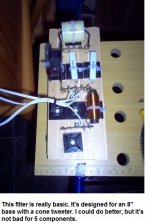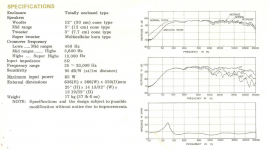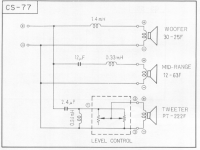Thanks Once Again Steve!
I will look to build a second order crossover around those values.
Here is the ohm values for speaker B:
Woofer B- Ohm= 8.2
Mid B- Ohm= 6.4
Tweet B- Ohm= 3.3
Your patience with a newbie like myself is greatly appreciated!
Best Regards,
Rich
I will look to build a second order crossover around those values.
Here is the ohm values for speaker B:
Woofer B- Ohm= 8.2
Mid B- Ohm= 6.4
Tweet B- Ohm= 3.3
Your patience with a newbie like myself is greatly appreciated!
Best Regards,
Rich
Rich, in the end, what you do is up to you. 🙂
I have a sufficient hang of this subject to just buy some decent cheap components and just throw them together. With a bit of lead-free solder.
It seems that you folks in the USA pay far too much for ferrite cores. We pick them up for about £5 a pop in the UK. Sandcast resistors cost about £1 a pop here.
Here's the sort of thing I do for crossovers. Frankly, driver quality makes more difference.
I have a sufficient hang of this subject to just buy some decent cheap components and just throw them together. With a bit of lead-free solder.
It seems that you folks in the USA pay far too much for ferrite cores. We pick them up for about £5 a pop in the UK. Sandcast resistors cost about £1 a pop here.
Here's the sort of thing I do for crossovers. Frankly, driver quality makes more difference.
Attachments
Holy Cow! That sure is nice work Steve. Maybe at some point I'll attain skills like that. This site will sure help in learning this stuff. I'll keep lurking around and asking a few questions when its appropriate without being a pain. lol
Thanks a million for all your help!
Best Regards,
Rich
Thanks a million for all your help!
Best Regards,
Rich
Hi Steve,
Just a brief follow up question regarding the proposed crossover upgrade. Do I retain the L pad for the tweeter or bypass it altogether since we already have a 4 ohm resistor in parallel. I did confirm by disconnecting taking the tweeter out of the circuit ohms increased to 6.4 like you mentioned it would.
Again much thanks!
Rich
Just a brief follow up question regarding the proposed crossover upgrade. Do I retain the L pad for the tweeter or bypass it altogether since we already have a 4 ohm resistor in parallel. I did confirm by disconnecting taking the tweeter out of the circuit ohms increased to 6.4 like you mentioned it would.
Again much thanks!
Rich
Hmmm...tweeters!

So, a brief summary:
It needs to stay on the vertical axys like the midrange and the woofer
It needs to be a new component: choice may be a little difficult because the sensitivity is unknown (and an L-pad becomes useful at this stage, when using tweeters having 93-95 dB sensitivity for a start )
The midrange: Ok, use the cilynder as a box. 😡
Don't trust me when I talk about X-overs ( 'cos it has to be verified at the latter stage )
a 1st order might sound wonderful ( electrical )
But...The midrange ( let's say a woofer ? ) in a closed box already has a 6 dB roll-off, so the final acoustical slope will be different.
It'll match with the roll-off exhibited by the woofer and they'll meet happily together at the -3dB point

So, a brief summary:
It needs to stay on the vertical axys like the midrange and the woofer
It needs to be a new component: choice may be a little difficult because the sensitivity is unknown (and an L-pad becomes useful at this stage, when using tweeters having 93-95 dB sensitivity for a start )
The midrange: Ok, use the cilynder as a box. 😡
Don't trust me when I talk about X-overs ( 'cos it has to be verified at the latter stage )
a 1st order might sound wonderful ( electrical )
But...The midrange ( let's say a woofer ? ) in a closed box already has a 6 dB roll-off, so the final acoustical slope will be different.
It'll match with the roll-off exhibited by the woofer and they'll meet happily together at the -3dB point
Thanks Pico,
I was looking at upgrading x-overs as Steve suggested. He posted a schematic for SEAS 503 model that is very close to mine except it is 2nd order. Confusion was setting in as to how the L- pad would interact within the design.
I appreciate the advice you have given! Just wanted to make one change at a time and learn what influences matter the most. I'm sure tweeter upgrade will take place sooner then latter.
Best regards,
Rich
I was looking at upgrading x-overs as Steve suggested. He posted a schematic for SEAS 503 model that is very close to mine except it is 2nd order. Confusion was setting in as to how the L- pad would interact within the design.
I appreciate the advice you have given! Just wanted to make one change at a time and learn what influences matter the most. I'm sure tweeter upgrade will take place sooner then latter.
Best regards,
Rich
Pioneer CS-77
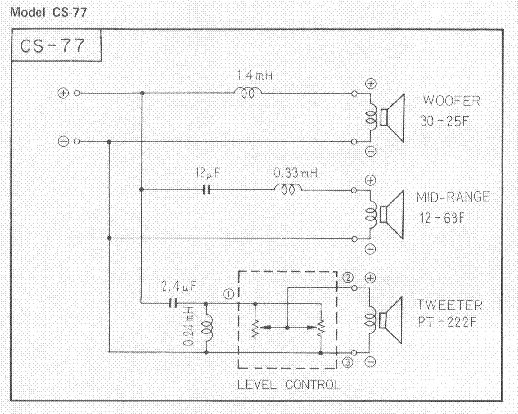
I proposed improving the bass rolloff with second-order 4.7mH coil and 3.3R plus 22uF shunt.
Add a 1R/15R attenuator to the mid and wire it negative polarity. The rest is unchanged. See how it sounds.

I proposed improving the bass rolloff with second-order 4.7mH coil and 3.3R plus 22uF shunt.
Add a 1R/15R attenuator to the mid and wire it negative polarity. The rest is unchanged. See how it sounds.
Last edited:
Excellent Steve,
It does not get much easier then that. I was just putting together items to order from Parts Express and did not want to miss a necessary component.
Really Appreciate Your Assistance!
Best Regards,
Rich
It does not get much easier then that. I was just putting together items to order from Parts Express and did not want to miss a necessary component.
Really Appreciate Your Assistance!
Best Regards,
Rich
I vote for working with the original drivers, since they likely are fabric surrounds and being Pioneer probably still sound like new…which given the crossover is a bit rough.
And powered subs are available in thrift stores everywhere
And powered subs are available in thrift stores everywhere
Last edited:
Yea,
These drivers are in great shape. I have decided to modify the crossover a bit to improve bass response. Later, as I gain more experience a diy project will arise that does not involve tossing out speakers that are in good working order.
Best Regards,
Rich
These drivers are in great shape. I have decided to modify the crossover a bit to improve bass response. Later, as I gain more experience a diy project will arise that does not involve tossing out speakers that are in good working order.
Best Regards,
Rich
That 1.4mH coil is a useful size for an 8" build at some stage. Should be able to get it off with a blade.Yea,
These drivers are in great shape. I have decided to modify the crossover a bit to improve bass response. Later, as I gain more experience a diy project will arise that does not involve tossing out speakers that are in good working order.
Best Regards,
Rich

But I think you can do the work on the existing circuit board with those solder tags available and some hook-up wire or 15-30A fusewire, which is usually tinned copper. Hot glue is useful too.
Thanks Steve,
There does seem to be enough room on the existing board. But, if things turned out to be to congested, I could add a small board near the open solder tags for the additional woofer components. Especially, the 4.7 mH coil and 22 uF cap. Keep the 3.30 ohm resistor for the woofer close to the open solder tags. Those are my initial thoughts at this stage. I will refer back to your work that you posted for layout ideas as well.
Best Regards,
Rich
There does seem to be enough room on the existing board. But, if things turned out to be to congested, I could add a small board near the open solder tags for the additional woofer components. Especially, the 4.7 mH coil and 22 uF cap. Keep the 3.30 ohm resistor for the woofer close to the open solder tags. Those are my initial thoughts at this stage. I will refer back to your work that you posted for layout ideas as well.
Best Regards,
Rich
Last edited:
A couple of things I have learnt.
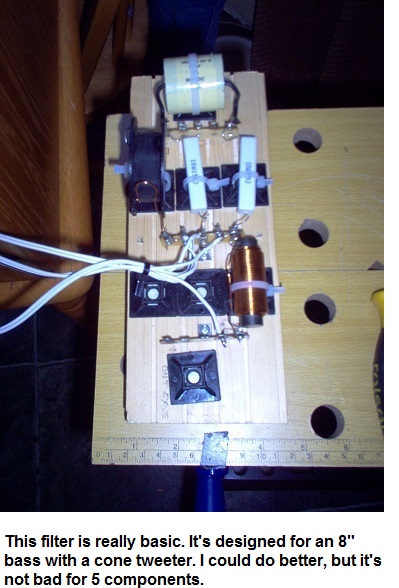
When you first heat up a modern 40W soldering iron, tin it immediately with solder. It preserves the tip from oxidisation, which you can't file down to fresh copper like the old ones which were designed for leaded solder.
Also keep the leads long on components. It saves heat damage and makes them more reuseable. Coils are often enamelled, so you scrape that off at the ends for fresh metal. Resistors and coils are tough as old boots, but capacitors are fragile, and you want to get in and out in about 5 seconds. If the solder isn't taking, exit and blow on the leads, and clean it all up and try again.

When you first heat up a modern 40W soldering iron, tin it immediately with solder. It preserves the tip from oxidisation, which you can't file down to fresh copper like the old ones which were designed for leaded solder.
Also keep the leads long on components. It saves heat damage and makes them more reuseable. Coils are often enamelled, so you scrape that off at the ends for fresh metal. Resistors and coils are tough as old boots, but capacitors are fragile, and you want to get in and out in about 5 seconds. If the solder isn't taking, exit and blow on the leads, and clean it all up and try again.
Hi Rich,
I had the same problem with these Pioneers CS-77. I measured the frequency response and i found that the mids were too pronounced. Listen to music on a low volume is ok, but by cranking up the music, the mids sounds too aggressiv.
So i opened the speakers and i added two resitors to the mid part of the crossover. 4.7 ohm and 8.2 ohm parallel to the speaker, to decrease mid level to 6dB.
After a first test, sound was better, and basses are way better audible. But for some good jazz or RnB not enough. So i decided to replace the woofer. After a few hours of browsing on the inet, i found one which TSP parameters are nearly compatible with the cabinet and not too expensive, the Visaton W300. This woofer sounds great, basses are very dynamic with a little modifications in the cabinet (hidden inside). You need to lengthening the bass reflex tube inside from the 12cm original to 22cm.
That's the trick about it. Now it sounds amazing. Just not comparable to before.
Hope that helped.
Adrian
I had the same problem with these Pioneers CS-77. I measured the frequency response and i found that the mids were too pronounced. Listen to music on a low volume is ok, but by cranking up the music, the mids sounds too aggressiv.
So i opened the speakers and i added two resitors to the mid part of the crossover. 4.7 ohm and 8.2 ohm parallel to the speaker, to decrease mid level to 6dB.
After a first test, sound was better, and basses are way better audible. But for some good jazz or RnB not enough. So i decided to replace the woofer. After a few hours of browsing on the inet, i found one which TSP parameters are nearly compatible with the cabinet and not too expensive, the Visaton W300. This woofer sounds great, basses are very dynamic with a little modifications in the cabinet (hidden inside). You need to lengthening the bass reflex tube inside from the 12cm original to 22cm.
An externally hosted image should be here but it was not working when we last tested it.
That's the trick about it. Now it sounds amazing. Just not comparable to before.
Hope that helped.
Adrian
Hi Adrian,
Nicely done! that is an awesome to find those Visaton woofers work so well. As for mine, I still have the cabinets but have turned them into bass modules that will house (2) Dayton RS225- 8" woofers in sealed enclosures. I will then build smaller 2way boxes that will sit on top. Something similar to Troels Gravesen Discovery 4.
Best Regards,
Rich
Nicely done! that is an awesome to find those Visaton woofers work so well. As for mine, I still have the cabinets but have turned them into bass modules that will house (2) Dayton RS225- 8" woofers in sealed enclosures. I will then build smaller 2way boxes that will sit on top. Something similar to Troels Gravesen Discovery 4.
Best Regards,
Rich
Hi, does anyone has the specs of the CS-77? Most of all the sensibility, I want to know if I can use them with my single ended 5 watt tube amp, thanks.
Thanks Lojzek, the crossover diagram is ok but the specs are from the CS-77A, a different speaker, a 4 way.
- Home
- Loudspeakers
- Multi-Way
- Pioneer CS-77 Speaker Mod Suggestions
